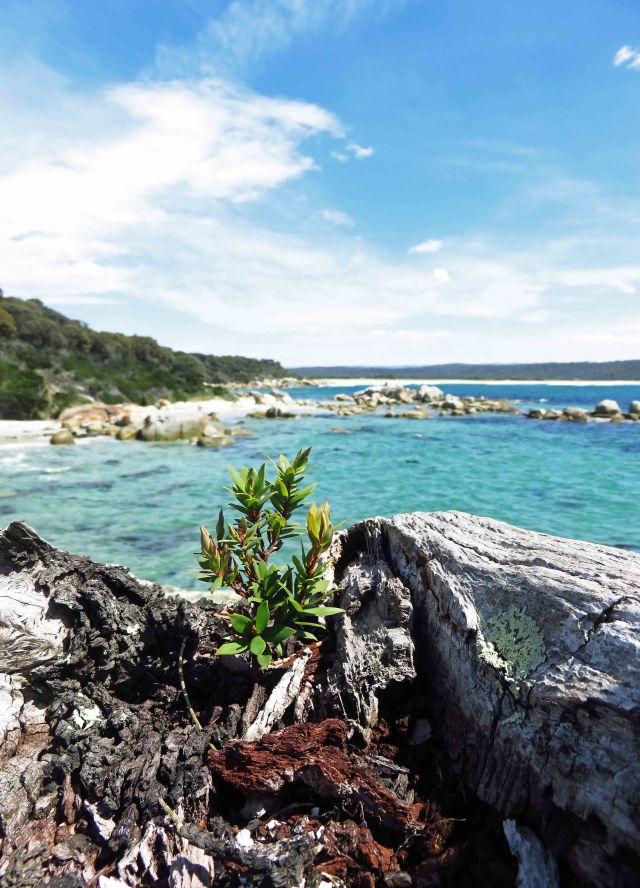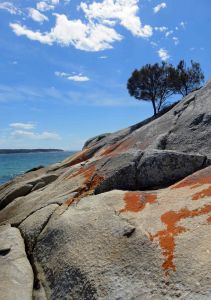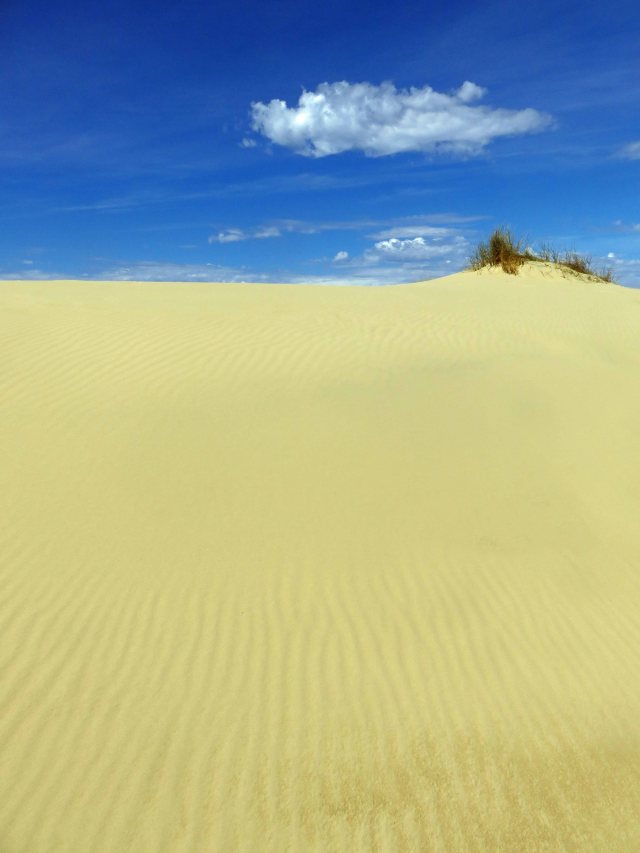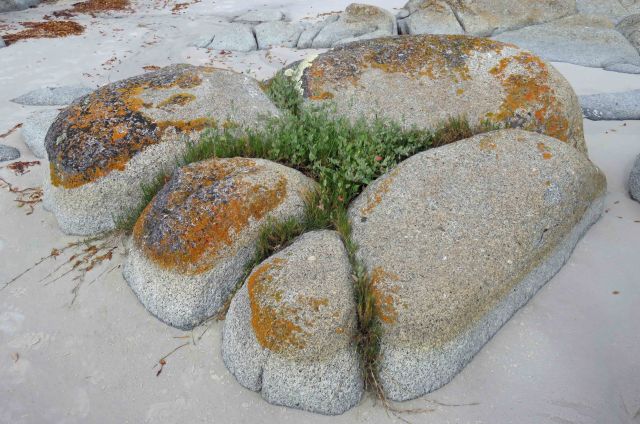It is common in revegetation/reforestation projects to have to start with a difficult site with harsh conditions, which can lead to poor results and discouragement.
Fortunately there is usually a variety of tough plants which will grow successfully, and improve the conditions for more tender species to be grown later. The photos below show plants surviving or even thriving in very demanding circumstances, proving that there is hope and that it can be done.
*

Seedling growing in a rotting log on top of granite boulders. (I think Coast beard-heath Leucopogon parviflorus, in Allocasuarina verticillata log). Burns Beach, near St Helens, Tasmania. Photo: David Clode.
Strangler and other fig seeds are dispersed by birds and mammals, and often germinate near the top of another tree, where there is more light. In wet tropical areas, if the people left, the cities would quickly look like Angkor Wat. More strangler fig photos below.
Photo taken at the Cairns library car park.
*
*
*

Soil? Who needs it! Two species of fig growing on a pylon on the jetty at Green Island, Cairns. Photo: David Clode
*
Cyclones (hurricanes) have broken off branches from this casuarina tree, and removed three quarters of the sand around its roots, and yet the tree still battles on.
*

Growing on rocky ground. Coast She-oaks looking like Stone Pines on the Mediterranean. Burns Beach, Tasmania. Allocasuarina verticillata.
*

Coast She-oak (or Drooping she-oak) Allocasuarina verticillata, prev. Casuarina stricta. The Gardens, Bay of Fires, Tasmania, coping with salty winds and growing on a rock. Photo: David Clode.
*
*

Pumice, driftwood and seeds washed up on a beach on Green Island after an unusually high tide. Photo: David Clode.
*

Seedlings germinating in a pile of pumice, washed up on the beach a few months earlier on Green Island (near the Casuarina photo above). Photo: David Clode.
*

A Bird’s-nest fern growing directly on a rock. Stoney Creek, Barron Gorge National Park. Cairns Australia.
*

Sclerophyll heathland vegetation growing in acid infertile pure sand with added coastal exposure. Steiglitz, Tasmania. Photo: David Clode.
*
*
A tree refuses to die:
This Enterolobium cyclocarpum or Earpod tree was blown over in a cyclone/hurricane (late January 2011). It was then cut off cleanly with a chainsaw. It promptly grew coppice growth from the stump, which was sawn off again. This is the second coppice growth.
As above, second coppice growth, 23 Dec 2011.
Same coppice growth, close up, 23 December 2011. The tree refuses to die.
October 2015. Tree wins!
October 2015.
***
A self-seeded tomato plant growing and fruiting in a crack in a car park in Cairns.
This cactus plant has been thrown out in a car park, has righted itself, and is growing happily. People throwing out plants and garden prunings is a major source of weed introduction to new areas, especially remnant bushland/vegetation in or near urban and suburban areas. Succulents in particular are often able to survive dessication, grow roots, and thrive as weeds e.g. Senecio spp., Opuntia spp., Sansevieria.
A Desmodium tortuosum self-seeded in a car park.
*

Note the three grasses by themselves – surviving heat, cold, dessication, strong salty winds, and relentless sand blasting. Peron Dunes, Tasmania. Photo: David Clode.
*
A Philodendron strangling a palm, Wodyetia bifurcata. This has been going on for decades, and the palm lives. Cairns Botanic gardens. Philo means friendly, and dendron means tree, so Philodendron could be loosely translated as “tree-hugger”.
This strangler fig grew around another plant, which later died and rotted away, leaving just the hollow lattice-work of the roots of the strangler fig.

This strangler fig root has grown about 27 metres along the top of a wall (see photo of the tree below), and then entered the ground 30 metres away from the tree. Who knows how far it has gone underground?
Strangler fig, Cairns. The 30m + root in the photo above grows off to the left. Photo taken near the second world war fuel storage tanks, and the wall was presumably built about that time, and the fig started growing sometime after that. Edge Hill, Cairns.
Below, a young fig seedling establishes itself in a plastered wall, looking like a bonsai plant. Edge Hill, Cairns.
*
Mangrove trees are tough – able to cope with saltwater and waterlogging.

Succulent Aloe arborescens plants in the foreground growing in the desert. Wadi Avdat, Negev desert, Israel. Photo: Dieter Prinz.
*

New growth from a Tasmanian Blue Gum, growing in a crack in rocks and exposed to salty sea winds and perhaps the occasional fire. Binalong bay Tasmania. photo: David Clode.
*

This eucalyptus tree is growing next to a creek in Melbourne. The soil has been washed away around its roots until it has fallen accross the creek, but it has produced new vertical growth from the horizontal trunk. Photo: David Clode.
*

A burnt eucalyptus tree continues to thrive after a fire. Mt dandenong, Victoria, Australia. Photo: David Clode.
*
*

Tough grass, probably Marram grass. Talk about an exposed position! Peron Dunes, Tasmania. Photo: David Clode.
*

Aizoaceae succulent surviving in crack in a rock right next to the sea. Most likely Disphyma crassifolium ssp. clavellatum. Beerbarrel Beach, Tasmania. Photo: David Clode.
***
Reforestation.me























Simply wanna remark on few general things, The website style is perfect, the written content is very wonderful : D.
LikeLike
Hi there, just wanted to mention, I enjoyed this article. It was practical. Keep on posting!
LikeLike
Straight to the point and well written! Why can’t everyone else be like this?
LikeLike
some truly prime articles on this site, saved to my bookmarks .
LikeLike
Some truly prime posts on this website , bookmarked .
LikeLike
It’s a pity you don’t have a donate button! I’d most certainly donate to this excellent blog! I guess for now i’ll settle for bookmarking and adding your RSS feed to my Google account. I look forward to new updates and will share this website with my Facebook group. Talk soon!
LikeLike
Woh I love your content , saved to my bookmarks ! .
LikeLike
Wow, fantastic blog layout! How long have you been blogging for? you make blogging look easy. The overall look of your web site is magnificent, let alone the content!. Thanks For Your article about Tough plants | reforestation.me .
LikeLike
Thanks for your great comments guys!
LikeLike
Great information. Lucky me I discovered your blog by accident (stumbleupon). I’ve bookmarked it for later!
LikeLike
I’ve read a few excellent stuff here. Certainly worth bookmarking for revisiting. I surprise how so much attempt you set to make any such magnificent informative web site.
LikeLike
Great information, thanks! Your style is amazingly informative and yet easy to read. It’s always a pleasure to visit your site. I always learn something new and definitely come away with new information and inspiration to make a difference to the land around me.
LikeLike